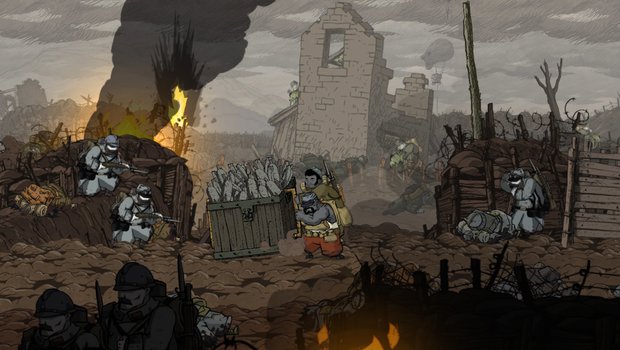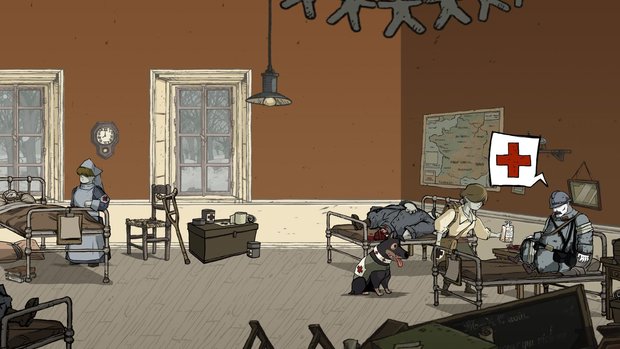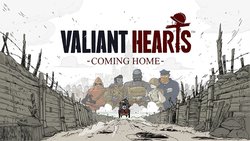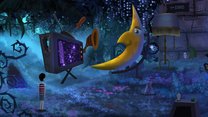Valiant Hearts: Coming Home review – No charge for short but stunning WWI mobile sequel available only through Netflix

- 1 Comment
Just as the so-called “war to end all wars” went on to spawn a sequel, so too did Ubisoft’s surprising 2014 cinematic side-scroller Valiant Hearts: The Great War, though not the same kind of successor and with far less fanfare. Indeed, you may not have even known that Coming Home existed, as it bypassed all the usual gaming channels and was launched exclusively for iOS and Android devices – and only available to Netflix subscribers. There must have been an enticing paycheque behind it, because otherwise it’s an odd and even vaguely disrespectful release model for fans who enjoyed the original game on PC or consoles. The limitations of mobile platforms do it no favours either, but besides the whole “subscriber-only” boondoggle, there’s plenty of good news waiting. The best part is: it’s FREE! It’s also very much in the same vein as its predecessor, although shorter and simpler, offering another gorgeous bit of engaging war-themed gameplay without so much as ever firing a gun, along with a little educational benefit to boot.
Development this time changed hands to Old Skull Games, but Coming Home looks and feels more like a natural extension of the first game than an entirely new sequel. It’s set a bit later in the war than the original, focusing mainly on the period after the American entry into the conflict, but it features the same kind of side-scrolling, beautifully hand-animated cinematic backgrounds; alternating cast of international characters; various educational collectibles to pick up along the way; and a mix of diverse if never overly challenging gameplay elements to keep things fresh. The locations are new, including a snow-covered Sainte-Ménehould, the muddy trenches near Vimy, and the Western front of the Meuse-Argonne offensive in France, among others made even more impressive by appearing at differing times of day and night.
A few characters from The Great War reprise their roles here, including the compassionate Belgian nurse Anna, American infantryman Freddie, and last but certainly not least: Walt the medical dog! There are new characters introduced here as well, and with them a change in focus for some of the scenarios. There’s an eccentric British pilot named George – so heavily masked and hooded that you never see his face – whose tendency to go rogue runs afoul of the RAF authorities and often lands him in trouble behind enemy lines. Ernst is a German civilian diver, spending his time salvaging wrecks before he’s captured and forced into action (or inaction, according to his conscience) aboard the deadly U-boat 155.

The final protagonist is James, Freddie’s musically inclined younger brother, who eagerly enlists along with hundreds of thousands of other African Americans, only to find that racism is very much alive and well in the U.S. Army. He and his troops go on to achieve great success, although only under the command of the French when the American military refuses to let black men join in the fight. They become known as the Harlem Hellfighters, but not before suffering numerous indignities touched upon with a relatively mild but unflinching touch throughout.
As with its predecessor, Coming Home seen you switch between protagonists at predetermined times. The stories aren’t entirely chronological but for the most part run concurrently, such that their fates are destined to intertwine at various points. Also as before, the game is largely wordless, with key objectives conveyed only through pictogram bubbles. There is a bit of in-game voice acting, and it’s very effective at setting the mood in certain scenarios, such as Anna’s desperate “You’re all right! Stay with me!” exhortations to wounded soldiers in her care. For the most part, however, the only voice you’ll hear is that of the narrator, who chimes in periodically to update players on what’s happening with the main characters, and laying out the geopolitical conditions to set the stage for the battle scenes to come. I’d have preferred perhaps a bit more voice-over, at least during important graphic novel-styled cutscenes, but the game does a good job of making you feel invested in its protagonists’ struggles even without it.
Arguably the best parts of Coming Home are the most adventure gamey segments. Here you’ll need to scour your immediate environs– a field hospital, a submarine, bombed-out buildings, sunken ship husks and the like – for necessary items, mostly moving horizontally but occasionally vertically as well. There’s no inventory, as you can carry only one item at a time, and some obstacles are simply fetch quests with various links in an item chain. Other times there’s some puzzle solving involved, like Ernst finding pipes he can rotate to re-route steam aboard his ship to sneak around covertly, or Anna locating keys and levers for crane-operated platforms to navigate environmental obstacle courses.

Even with people dying and all hell breaking loose around you, there’s no danger or any urgency in these scenes, nor any kind of real dexterity involved. Your only (human) abilities are to run, climb, push/pull crates, and pick up small objects that you can aim and throw at relevant targets via an on-screen trajectory outline. Adding a welcome extra layer of strategy is Walt, who’s not just an awesome support animal for the few occasions he accompanies you, but an integral part of accomplishing your goals. He’s not a playable character, but an icon with his likeness appears whenever he’s with you, so you can click on it to see if there’s any active hotspots you can “use” him on, whether an item to collect, a switch he can activate, or a small hole he can squeeze through that you cannot. Again, nothing at all difficult given how streamlined the process is, but more Walt is always a good thing.
I said there’s no danger in those scenes, but this is war, so of course there are times you’ll face real life-and-death stakes. My next favourite scenarios take place on the battlefield, where you’ll need to dodge incoming bombs (forewarned by target shadows on the ground where they’ll hit) and slip between hails of incoming enemy bullets in the background that you can’t possibly outrun – or survive; one hit and you’re dead, with no way to heal. These sequences are impressively cinematic for what amounts to an animated comic. With the sounds of war blaring and many moving parts, from gunfire to fellow soldiers to airplanes providing cover support, you’ll actually feel like you’re in the middle of a battle. Well, a game battle, obviously. Unlike actual war, mortality here is barely even a nuisance, as you’re almost instantly respawned close at hand to try again.
Perhaps the only real physical challenge – and still a relatively minor one – comes from George’s three forward-facing flight scenes. Replacing the surface-level car chases of the first game, in Coming Home you’ll take to the skies in planes and have to evade bombs, enemy fighters, and even inclement weather when a lightning storm arises. As always, you can’t fire back, so all you can do is move around the screen until the current threat passes, giving you a moment’s respite before the next. Still simple, but they go on a bit longer than is fun, and it’s here that the mobile-only controls are at their cumbersome worst.

Movement occurs by touching and holding the screen in the direction you want your character to go, but precision control is rarely an issue, so for the most part the only thing that can go wrong is the odd clunky sequence where your input is misinterpreted in tight spaces (climbing a ladder instead of moving away from it, for example). In flight, however, you need to have your finger constantly poised to slide around the screen, which means your hand may well be blocking a warning of incoming threats from the screen edges. “Killed by your own hand” doesn’t mean suicide in this case, but a big fat appendage inadvertently providing enemy cover! Still, a quick reload and you’re back up among the clouds.
Occasional stealth sequences involve ducking behind hiding spots in layered background elements and creating distractions in the limited ways you’re able. A couple other minigames are sprinkled in as well: Ernst can save drowning sailors from choppy waters by throwing them well-aimed life preservers, while as a nurse Anna regularly treats wounded soldiers, which means getting hands-on with their injuries. This plays out like a little Quick Time Event of sorts, though a repetitive and easily predictable one. Swiping the screen in the indicated (and obvious) direction will remove shrapnel, rubbing a (non-gross) bloody patch will clean it, and so on. There may be time limits or other ways to fail, but if so, you’d have to try really hard to do it. And who’d want to do that when you’re treated to a nice heart bubble afterward by your grateful patient?
It’s a bit easier to muff a clarinet note during one of James’s rhythm-based minigames (no musical ability required), but I couldn’t imagine even the most fumble-fingered player blowing a whole ensemble performance, if that’s even possible. Even outside of those sequences, music plays throughout Coming Home, ranging from intense battlefield backdrops, to familiar classical orchestral pieces, to sombre piano- and violin-heavy numbers during the more poignant, serious scenes. Yes, there are some of those. Some are joyful and touching, but while the game largely pulls it punches from the worst effects of war, it’s not above the unexpected dagger to remind you in its own small way of the real suffering, sacrifice and devastation of WWI.
Another deadly serious topic is racism, and the developers have done a good job of addressing it without ever feeling heavy-handed. In fact, the game is far more focused on celebrating the accomplishments of the 369th infantry Regiment than it is on the abuse they endured, but the latter is still plainly implied in little ways right from the opening moments of its segregated boot camp. That actually works in the game’s favour – at least at first – because it helps explain why James is forced to do joe jobs like preparing food and supplying soldiers with equipment and ordnance instead of ever firing a gun himself. It makes less sense once the Hellfighters are cleared for combat, but by then you’ll be willing to roll with it. This is not a game about killing the enemy, but a game about rising above obstacles in whatever form they may take.
I didn’t time myself while playing, but each of the three chapters probably took me about an hour to complete at most, broken into many individual levels that can be replayed. The experience is significantly shorter and at least felt easier than the first game as I recall it – but hey, free. You can add more time if you seek out all 50-plus collectibles (highlighted in the environment, but subtly enough that they’re easy to miss), each based on an object of interest from the period. You can read more about them in the game’s internal encyclopedia, along with other historical facts and diaries from James, Anna and the other protagonists for deeper thoughts not expressed during the game itself. The educational component isn’t too in-depth, but it will surely be enough to inspire further research into topics that interest you. I was certainly eager to learn more about the Harlem Hellfighters, whom I’d never even heard of before this.
Final Verdict
If you liked The Great War and subscribe to Netflix, my recommendation couldn’t be simpler: duh! It’s free, it’s fun, and offers more of the same best elements of its predecessor, at least if you can figure out how to access it. If you’re a Netflix subscriber but haven’t played the first game, go ahead anyway! Despite the overlap between them, there’s really no reason you need to have played the first game to enjoy the second. (Although don’t be surprised if you end up going back and picking it up afterward.) If you’re not into Netflix it’s a much harder sell for such a short and easy game, and having played on an iPad, I can’t imagine enjoying it as much on a smaller phone if that’s all you’ve got. But whatever your circumstances, Valiant Hearts: Coming Home is a diverting little successor that knew not to fix what wasn’t broken, while adding an insightful new angle to make it worthwhile in its own right. Sure, it’s a bit too streamlined for its own good, but for a little slice of wartime make-believe, it’s a blast.
Hot take
Valiant Heart: Coming Home’s limited release strategy is a self-inflicted wound, but this beautiful WWI side-scrolling sequel is a fairly fun, lightly educational little three-hour engagement free to those equipped to play it.
Pros
- Gorgeous comic-styled artwork is surprisingly cinematic
- Alternating characters and varied gameplay keeps things fresh
- Some delightful character moments and intriguing edutainment elements
- It’s free!
Cons
- Much shorter and at least somewhat easier than its predecessor
- Touch-screen controls can be a little clunky
- Sure hope you have Netflix!
Jack played Valiant Hearts: Coming Home on iPad, free with a Netflix subscription.

- Advertisement
- Help support AGH by advertising with us











1 Comment
Want to join the discussion? Leave a comment as guest, sign in or register.
Sounds like a flawed but interesting sequel to the original flawed but interesting game. But myself, there's no way I'm getting Netflix. So I'm happy to wait until it comes to another platform.
Reply
Leave a comment